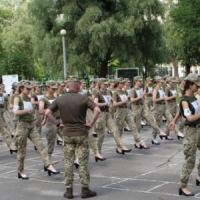Zhurzhenko, T. (2015). “Gender, Nation and Reproduction: Demographic Discourses and Politics in Ukraine after the Orange Revolution”. in Gender, Politics and Society in Ukraine
Though most literature on family in Ukraine highlights family as a private matter, for instance with regards to domestic violence, this article points to the many ways in which the state is interconnected with the family. The family and intimate life of individuals is often narrated in close connection to narratives of the nation. This is also the case in terms of family planning and childbirth, where Yuschenko openly encouraged families to have more children, for instance. Whether this pro-natalist agenda has grown after the Orange Revolution is contested. However, the one-time benefit upon the birth of the first child was raised from less than 800 UAH to 8,500 UAH in 2005. This sum was raised again to 12,240 UAH in 2008, while the mother gets 25,000 UAH upon the birth of the second child and 50,000 UAH upon the birth of the third (and every next) child. Pro-natalist politics is a contested measure of changing the critical demographic situation in Ukraine, where the population is constantly shrinking due to low birth rates, labour migration, etc. Though many politicians view this system of benefits as encouraging higher birth rates, experts have doubts about their long-term effect. They view the benefits as instruments of social protection for vulnerable social groups, because Ukrainian families with three or more children often live in poverty. All state initiatives regarding fertility affect women first and foremost. Mothers that are dependent on state support are often faced with double responsibilities, because state authorities hold them responsible for the social conduct of their children. Though pro-natalist concepts have not been translated into strict abortion-laws in Ukraine, the social consequences for women are seen in their economic status and their access to the labour market. There is a political fear that weaker gender norms and female emancipation would lead to a fertility drop. Yet Scandinavian politics suggest that birth rates can increase through shared parental leave and other policies that enhance female emancipation and labour market participation. Though some steps have been taken to bridge the gender gap in child care in Ukraine, the sufficient structural changes are not in place yet.
Perelli-Harris, B. (2008). Family Formation in Post-Soviet Ukraine: Changing Effects of Education in a Period of Rapid Social Change. Social Forces, 87(2), pp.767-794
In this study, Perelli-Harris investigates the correlation between child-bearing and education, exploring the causes of low birth rates in contemporary Ukraine. She writes that after Ukraine gained independence, maternity leave was expanded to three years, yet women (who had previously been employed) were paid 6 dollars per month and not 14 dollars as mandated by law. Furthermore, state-subsidized child care facilities declined by a third after 1990, both because of declining birth rates and because of privatization. Women therefore needed to take long maternity leaves or earn high salaries to afford day-care. Modern contraceptive methods have become more frequently used in the past decade. From 1994-1999, the amount of women ages 15-39 that used contraceptive methods increased by about 7 percent. The most recent data shows that 68 percent of married women and women living with a male partner use some form of contraception. In comparison with women with secondary or lower education, women with more than a secondary education are more likely to use contraceptives. By international standards, Ukrainian abortion rates are quite high. Marriage and childbearing have become less connected after the independence. Births outside of marriage increased from 11 percent in 1990 to 19 percent in 2002.
Wesolowski, K. (2015). Maybe Baby? Reproductive Behaviour, Fertility Intentions, and Family Policies in Post-communist Countries, with a Special Focus on Ukraine
In this thesis, Wesolowski comprises her research on gender and reproductive behaviour in Ukraine and Russia. She describes gender ideology and family policies in the Soviet Union and further compares post-Soviet Russia and Ukraine in terms of fertility rates, women’s living conditions and further developments in the countries’ family policies. She briefly summarizes the articles that the thesis is comprised of. The most relevant article for gender in the Ukrainian context, Prevalence and Correlates of the Use of Contraceptive Methods by Women in Ukraine in 1999 and 2007, is described in detail below.
Wesolowski, K. (2015). Prevalence and Correlates of the Use of Contraceptive Methods by Women in Ukraine in 1999 and 2007. Europe-Asia Studies, 67(10), pp.1523–1526.
In this article, Wesolowski presents her research on how Ukrainian state biopolitics influence contraception-usage in Ukraine (1999-2007). In Ukraine, several post-independence programs have focused on the reproductive health of the population, aiming to reduce abortion rates and to increase the use of modern contraceptive methods. The use of contraception decreased slightly between 1999 and 2007. This could partly be explained by the fact that a higher percentage of women were single in 2007 compared to 1999. However, modern contraceptive methods such as pills, condoms and IUDs have gained prevalence over traditional methods. Condoms are the most common contraceptive, because they are readily available and the cheapest solution. The study indicates that exposure to family-planning-messages correlates with the use of modern contraceptive methods. This may signify that state-induced family planning programs and biopolitics influence women’s contraceptive choice. However, the correlation could be due to other factors, which means that further research in the field is necessary.
Hilevych Y. (2014) Abortion and gender relationships in Ukraine, 1955–1970. The History of the Family. Routledge
In this article, Hilevych investigates the sociocultural conditions and culture regarding abortion in Soviet Ukraine 1955-1970, when modern contraceptives were not available, but abortion was legal. Based on in-depth biographical interviews and archival materials, she investigates how decisions regarding abortion were made in Lviv and Kharkiv. She finds that patriarchal gender regimes and spousal dynamics shaped when and how women took a stance regarding birth control and abortion in their relationship. In couples where spouses communicated about both birth control and abortion, the women sought less abortions and the men took more responsibility. This was more common in Lviv than Kharkiv. In Kharkiv, abortion was used to limit the size of the family, and spouses did not communicate about birth control and abortion. Birth control was considered a male domain and abortion a female. In these cases, women would seek abortions, both in their own interest and to maintain the patriarchal order in their marriage. In both Lviv and Kharkiv, couples conformed to the view of women being ignorant in sexual matters and men being responsible for birth control. Finally, Hilevych’ research suggests that women’s agency with regards to family planning can be highly reinforced through their peer networks.



















